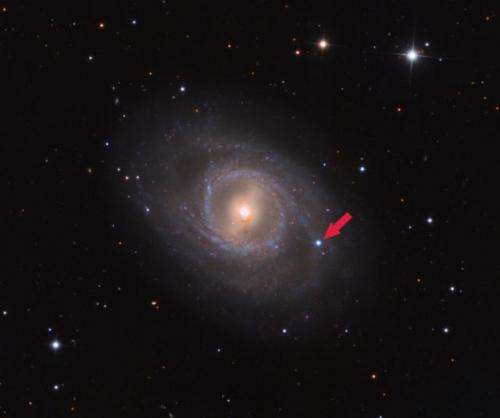Watching a star explode

NASA's Astronomy Picture of the Day for March 22 features a snapshot of a supernova - a massive star explosion - discovered only a week ago.
Using the remotely controlled Schulman Telescope at the University of Arizona's Mt. Lemmon SkyCenter, Adam Block shot this beautiful image of galaxy M95.
What appears to be an extra-bright star in one of its spiral arms actually is the light flash of a supernova. In this case, M95's latest supernova, SN 2012aw, was discovered on March 16 and now is identified as the explosion of a massive star.
"When I learned about the discovery of this supernova, I decided I could do without sleep for a night and try and take a good picture of this cosmic catastrophe," said Block, an astrophotographer. Collecting the light with the telescope took about three hours, followed by another three hours to assemble the final image.
The Schulman Telescope is large enough to clearly see both the galaxy and the supernova, which looks like a bright star, Block said.

Massive stars are the universe's hot, fast and furious: Ranging in mass from eight times to about 300 times the mass of our sun, they burn brighter than other stars, use up their fuel faster and go out with a bang of truly cosmic proportions.
"When you see the galaxy, you are looking at the combined glow of hundreds of billions of stars that are in that galaxy," Block said. "The fact that supernova rivals the brightness of the entire galaxy tells you something about how much energy is released."
Massive stars are rare, and astronomers must look many thousands of light years away from the Earth to discover one. Because they are difficult to see the further away they are, astronomers have yet to discover massive stars outside our own galaxy, the Milky Way.
Galaxy M95, in which supernova SN 2012aw went off, is about 38 million light years distant and spans about 75,000 light years across. M95 is a so-called barred spiral galaxy because of the bar-like feature in its center.
Apart from the latest supernova, galaxy M95 is special in that it helped astronomers figure out the shape of our Milky Way, Block said: "Trying to determine the shape of our own galaxy is tricky because we're in it. It's like trying to figure out the shape of your house while you're sitting in the living room."
Through various observations and measurements, astronomers were able to determine that the Milky Way, too, features a bar structure in its center and is roughly the same size as M95.
He added that right now, galaxy M95 is located in the approximate direction of Mars, in the constellation of Leo. While not visible with the naked eye, galaxy and supernova make for a good target for small telescopes.
"Depending on the nature of the explosion and the kind of star that blew up, we should be able to see the supernova for another couple of weeks or so," Block said. "At Mt. Lemmon SkyCenter, we want to make the universe exciting to people. What better thing to highlight than a star exploding in another galaxy?"
Provided by University of Arizona



















